Toyota Tundra 2nd Generation
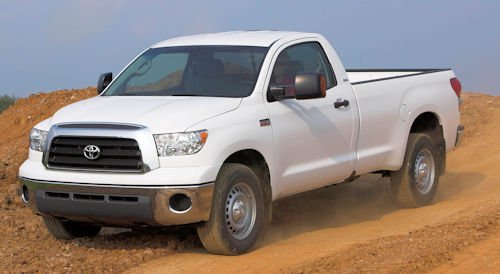 |
|
|
Model code |
XK50 |
|
Production |
2006 to 2021 |
|
Body style |
|
|
Engine |
|
|
Transmission |
|
|
Wheelbase |
|
|
Length |
|
|
Width |
79.9 in (2,029 mm) |
|
Height |
|
A larger tundra was unveiled at the 2006 Chicago Auto Show . This resembled in some details his smaller sister model Tacoma , in another concept vehicle FTX . A special detail were fenders that were formed into the body. The pickup had been improved in many ways; For example, the permissible trailer load increased to over 4,500 kg, the payload to over 900 kg and he got a new 5.7 -liter V8 engine (type Toyota 3UR-FE) in conjunction with a six-speed automatic transmission. Thus, there were three engines available for the second-generation Tundra: the new 5.7-liter V8 with an output of 381 bhp (280 kW) and a torque of 544 Nm, the old 4.7-liter V8, Type 2UZ-FE, with an output of 276 bhp (203 kW) and a torque of 424 Nm and the old 4.0 l V6, type 1GR-FE, with 236 bhp (174 kW) power and a torque of 361 nm.Its empty weight is 2078-4147 kg.
When the new Tundra came out in February 2007, the model was available in 31 different versions: three flatbeds, three cab versions, four wheelbases and two gearboxes. A new twin cabin replaced the old elongated cab and instead of the old twin cab there was a once more extended version that competes successfully with the Dodge Ram Mega Cab. The double cabin is available with flatbeds of 1,980 mm, normal length and 2,430 mm, while the extended double cabin is only available with a short bunk of 1,676 mm in length. The Tundra also has a new six-speed automatic transmission with lock-up in fifth and sixth gear - standard on the 5.7-liter V8. The vehicle accelerates from 0 to 100 km / h in 6.3 seconds and manages the quarter mile in 14.7 seconds.
Toyota created a tundra, which can be used for many construction works; It has extra large door handles, a rail system on the bunk, built-in draw hooks and headrests that can be adapted for workers wearing safety helmets. Furthermore, the Tundra comes as standard with a partially lockable differential (Auto-LSD), stability control (VSC), slip control (TRAC), electronic brake force distribution (EBD), brake assist (BAS), anti-lock braking system (ABS) and a tailgate assistant. However, its high base price of $ 22,390 makes it more expensive than the Chevrolet Silverado ($ 17,860) and the base version of the Ford F-150 ($ 17,345).
Some other enhancements that Toyota has made to the Tundra are optional rear-view mirrors (farther out on the vehicle to allow for wider trailers), a 100-liter petrol tank, optional 22 "aluminum wheels, rear-view camera, a Bluetooth port, a large center console (big enough for a laptop with 15 "screen), extra large brake discs and tongs and the previously mentioned 6-speed automatic transmission.
Tundra-grade models come with a standard AM/FM/CD stereo with six speakers (four speakers on Regular Cab models) and an audio input jack; SR5 models add a six-disc in-dash CD changer, and offer an available JBL AM/FM audio system with six-disc in-dash CD changer, 440-watt 5.1 channel surround sound, 10 speakers (12 in CrewMax), Bluetooth compatibility, and steering wheel audio controls. This system (with 10 speakers) is standard on the Tundra grade. All Tundra audio systems can play MP3/WMA formatted CDs.CrewMax models offer an optional Rear Seat Entertainment (RSE) system that combines a nine-inch wide-screen LCD monitor, DVD player, two sets of wireless headphones and a remote control. An available DVD navigation system includes a JBL audio system and integrates a rear backup camera. The camera automatically projects an image of what its lens can detect behind the vehicle onto the navigation system's LCD screen when reverse gear is engaged, useful when backing up the Tundra to a trailer, or for positioning a boat trailer on a launch ramp. A multifunction rear view mirror, standard on Limited grade models
and optional for others, combines an electrochromic auto-dimming mirror with a digital compass and HomeLink transceiver.
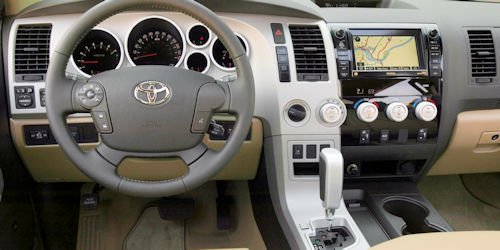
All Tundra with 5.7-liter V8 engines are equipped with a traction package that includes an engine and automatic transmission oil cooler, a trailer hitch, a 1: 4.3 ratio rear axle ratio, and extra-large anti-premature fade brakes .The Tundra's 5.7-liter i-Force V8 is available in every model configuration. Specifically engineered for full-size pickup applications, the i-Force 5.7-liter uses a long-stroke design (stroke dimension of 4.02 in. is more than the bore width of 3.70 in.). As a result, in addition to its impressive 381 horsepower at 5,600 rpm,the i-Force 5.7 produces 401 lb.-ft of peak torque at 3,600 rpm. The i-Force 5.7 V8 uses aluminum for the cylinder block and DOHC heads. A Dual Independent VVT-i system controls valve timing and overlap on both the intake and exhaust valves independently of each other, which helps optimize power and fuel efficiency while minimizing emissions.
All Tundra engines are equipped with the Acoustic Control Induction System (ACIS). Butterfly valves inside intake manifold switch the length of the intake runners in two stages, based on rpm and throttle angle, to improve efficiency across the engine speed range.
The new Tundra is being built in two plants in the United States . Firstly, in Princeton (Indiana), and secondly in the new plant in San Antonio (Texas). While approximately 100,000 tundra can be built in Princeton per year, approximately 200,000 units leave the new plant in San Antonio each year. When this new plant was built, Toyota led 21 major suppliers to build factories on the same site to avoid logistical issues. As a result, these suppliers became even more dependent on Toyota. Toyota also invested US $ 9 million in health care for its employees and their dependents.
Since 2008, all Tundra are built in Texas. Engines and drive components of the Tundra are only manufactured in factories in the USA.
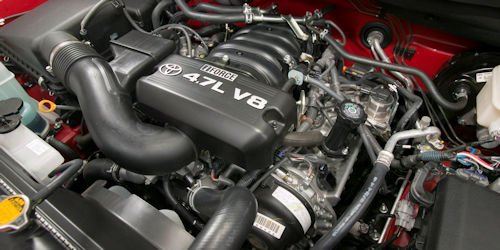
Engines
Model Years 2007-2009
- 4.0 l V6, type 1GR-FE, 236 bhp (174 kW), 361 Nm, LEV II
- 4.7-liter V8, type 2UZ-FE, 276 bhp (203 kW), 424 Nm, LEV II
- 5.7-liter V8, type 3UR-FE, 381 bhp (280 kW), 544 Nm, ULEV II
Model year 2010
- 4.0 l V6, type 1GR-FE, 236 bhp (174 kW), 361 Nm, LEV II
- 4.6-l V8, type 3UZ-FE, 310 bhp (228 kW), 444 Nm, ULEV II
- 5.7-liter V8, type 3UR-FE, 381 bhp (280 kW), 544 Nm, ULEV II
Changes from model year to model year
- From 2008, an additional 13 variants were offered, so that there were a total of 44 model variants. The 2008 models had better features and lower prices; In addition there was a new Tundra version below the equipment SR5, which was intended for business people and customers who pay close attention to the price.
- Since 2009, all tundra with 5.7-liter V8 engine in certain regions are suitable for ethanol operation (E85) as standard. Toyota upgraded the TRD Sport package and offered a TRD Rock Warrior package. Compared with the previous year, prices rose by 0.4%.
- The tundra of the model year 2010, grille and taillights have been revised. There is now a new top package called Platinum . And there's a new 4.6-liter V8 engine with a six-speed automatic transmission instead of the previous 4.7-liter V8. Standard knee airbags for the driver and front passenger ensured that five new stars were awarded in a new NHTSA frontal impact test. The first Tundra The 2010 model year were delivered in late April 2009 to the dealer.
Security Aspects
The Tundra is now equipped with two front airbags, two side airbags for the front seats and curtain airbags with a rollover sensor for all rows of seats. Also included are stability control (VSC), slip control (TRAC), anti-lock braking system (ABS) and electronic brake force distribution (EBD). As of model year 2010 are also included knee airbags for driver and front passenger as standard.
The Toyota Tundra was the first big pickup to earn the IIHS's Top Safety Pick ; 2009 followed the new Ford F-150 .The competitors of GM, Dodge and Nissan could this designation does not deserve, because their values "sufficient" for side impact or as "poor" were assessed. In the experiments carried out by the IIHS frontal impact tests the tundra reached the "good" the highest possible rating in the side impact test and also the maximum rating for rear crash protection.
In the NHTSA tests, the 2007-2009 model Tundra got four out of five stars in frontal impact, both for the driver and the passenger seat. The model 2010 but got all five stars in this discipline. If the risk of serious injury is 11-20%, the car will be given four stars, for five stars it will be less than 10%.
The main difference between the IIHS and NHTSA front impact tests is that the former performs an offset impact with partial coverage of the vehicle fronts, while the latter tests a direct frontal impact. The offset impact more demands the structure of the vehicle, while the direct frontal impact more stress the restraint systems. In both cases, the tests are comparable only if both accident opponents have approximately the same weight.
Because the VSC system of the Tundra is switched off when the vehicle is switched to four-wheel drive, Consumer Reports raised the question of whether the title Top Safety Pick in this case really justified. Toyota's response was that the Tundra had a rigid connection between the front and rear axles in four-wheel drive and a stability control would therefore not work. In the front-wheel drive operation but the stability control remains active and choose most riders all-wheel drive only on slippery surfaces.
STAR SAFETY SYSTEM TM Traction Control (TRAC, A-TRAC on 4x4 only) plus Vehicle Stability Control (VSC), four-wheel Anti-lock Brake System with Brake Assist and Electronic Brake-force Distribution Driver and front passenger advanced airbags. Passenger airbag cut-off switch on Regular Cab ONLY.
Headrests in all seating positions Adjustable front seatbelt shoulder anchors (outboard seating positions only) Three-point seatbelts in all seating positions; Emergency Locking Retractors (ELR) on driver's belt, front passenger-side Automatic/Emergency Locking Retractors (ALR/ELR); Front seat belt pretensioners and force limiters
Three-point rear seatbelts with Automatic/Emergency Locking Retractor (ALR/ELR) — Double Cab & CrewMax models Rear Center High Mount Stop Lamp (CHMSL) with cargo lamp.Side-impact door beams in all doors CRS tether anchors — on all models; CRS lower anchor for front passenger seat on Regular Cabs. CRS lower anchor for rear outboard seats for Double Cab & CrewMax models Child protector rear door locks — Double Cab & CrewMax models Curtain airbags and front seat side airbags
Roots blower Compressor from TRD
Since June 2008, there is the compressor for the 5.7 -liter V8 engine from Toyota Racing Development (TRD). The engine power thus increases to 504 bhp (376 kW) and the maximum torque to 750 Nm. If installed at a Toyota dealer, the original warranty is retained. This kit contains two Roots blower of Eaton with two four-wing rotors, a construction as in the newly introduced TRD Aurion , the Chevrolet Corvette C6 ZR1 and the Cadillac CTS-V is used. The official retail price for the kit is 5,875 US dollars .
Special models
In June 2008 Toyota introduced the Ivan "Ironman" Stewart Signature series of the Tundra. There were three different special equipment packages, one of which included the TRD compressor. Stewart had won the Baja 500 seventeen times with Toyota.
In 2004, the Tundra participated in the NASCAR Camping World Truck Series and won for the first time at the Michigan International Speedway on July 31 this year. In 2006, the Tundra won the Toyota Constructors' Competition for the first time, winning 12 out of 25 races. The model also won the drivers championship with Todd Bodine and Germaine Racing at the wheel.
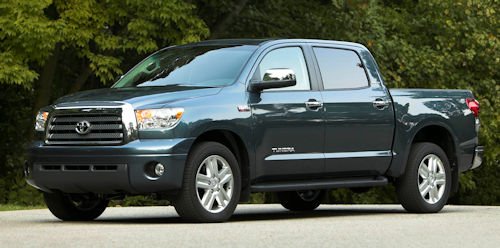
Callbacks in the model year 2007
In May 2007, a Toyota spokesman admitted that the brand new 5.7-liter V8, 3UR-FE, has seen twenty cases of camshaft failure. Toyota said this failure was a result of cracks in the casting process of the camshafts, and the supplier had in the meantime eliminated this error. In other cases, Toyota would either exchange the entire engine and extend the warranty or buy back the whole car from the owner. Actually Toyota wanted to start with the sale of the Tundra with 5.7 -liter V8 in the summer of 2007, but then decided to take the engine earlier in mass production and release the model in February 2007. This decision was made
On December 13, 2007, Toyota called 15,600 four-wheel models of the tundra vintage 2007 in the workshops, because with them the rear propeller shaft could have broken. "There is a possibility that a connection in the rear propeller shaft has been heat-treated incorrectly and therefore does not have the right hardness," Toyota said, adding, "This can lead to a breakage of the cardan shaft in the area of this connection."There was a single case of peculiar noise in an affected vehicle. But there are no known accidents due to this error. From December 2007, all concerned Toyota owners were contacted and should contact their local Toyota dealer for an inspection and, if necessary, swap the propshaft.
In the Report of Consumer Reports 2007, the four-wheel tundra got a bad reliability rating mainly due to problems with the four-wheel drive . However, on November 10, 2008, the new report from Consumer Reports said that Toyota apparently corrected the issues. The rating is now "average" and it is a buy recommendation.
At the Tokyo Motor Show 2007, a Toyota-Manger found that the quality defects had brought "shame" on the company. In July 2006, Toyota board member Watanabe apologized for the quality loss, but promised that the company would make a significant effort to address these issues.
Tundra Diesel
In September 2007, Toyota announced plans to launch a diesel variant of the Tundra. This was also at the North American International Auto Show confirmed in January of 2008. Toyota board member Watanabe said, "I am pleased to confirm that a new, clean V8 diesel engine will be offered in the Sequoia and Tundra models in the near future." But later in 2008, a Toyota executive said at the state show in Texas that they wanted to wait with the launch of the Tundra Diesel, because the model sold worse than expected.
At the 2007 SEMA Auto Show Toyota showed its Tundra Diesel Dually Project Truck. This heavy-duty tundra diesel is based on the heavily modified chassis of the Tundra CrewMax. He has an 8.0-liter V8 Hino diesel engine, a manual transmission from Eaton and several other changes.
At the end of 2006, Toyota bought off shares of Isuzu . The Duramax V8 engine from Isuzu drives currently the 0.75- and 1-ton pickups from GM, but the engine for the 0.5-ton diesel is to be completely designed and built by GM only there become.
The Australian version of the Toyota Land Cruiser has a 4.5-liter V8 diesel engine, which could also be based on a future Tundra diesel.
Tundra Hybrid
Toyota CEO Katsuaki Watanabe has announced that he would like to build a hybrid version of the Tundra. But Toyota still has some technical issues to solve before such a vehicle can hit the market.
According to the Japanese newspaper Nihon Keizai Shimbun, Toyota is considering developing a hybrid gasoline-electric tundra around 2010 in North America.
Toyota could also develop a diesel-electric hybrid for the tundra. In Japan, the transporter models Dyna and Hino Dutro have such a system. The Hino Ranger , a mid-sized hatchback truck, could also provide a hybrid system for the next generation tundra.
At the North American International Auto Show 2008, Toyota USA CEO Jim Lentz noted, "Different models need different fuel economy technologies There are certainly a number (of models) where hybrid technology makes no sense." , This further stated that the Sequoia and the Tundra in the near future, no hybrid variants are provided, instead, these models should "get clean and efficient diesel engines." At the moment it seems that the Tundra Hybrid has been transferred back to the design departments or even completely canceled.
Sales figures
The sales figures of the Toyota Tundra since 2000 are completely or almost at the production capacity limit. The factory in Indiana can produce 130,000 tundra a year. The Tundra has been on the market for over 5 years now and accounts for 17% of the market for 0.5 tonne pickups. In 2000, Toyota sold 107,798 tundra, which represents a significant improvement over the sales of its predecessor T100 with approximately 50,000 copies per year. In 2005, Toyota sold 126,529 tundra. The best-selling Ford F-150 was sold 756,980 times in the same year. With the capacities of the new plant in Texas Toyota wanted to sell 2007 approximately 200,000 tundra. The company narrowly missed this goal.
Currently, around 70-80% of tundra sales are on the 5.7-liter model and 46% of the cars sold are CrewMax. The double cabs are also selling well, but the standard pickup trucks are much less in demand than expected.
The tundra is gaining ground; In July 2007, 23,150 units were sold, more than GMC Sierra in the same month, albeit significantly less than the Sierra twin Chevrolet Silverado. In 2007, the GMC Sierra sold 12,000 more than the Tundra, Silverado more than 422,000, and the F-150 re-launched the list of sales.
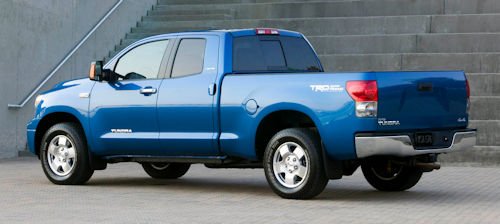
Technical
-
ENGINES
4.0-liter DOHC EFI V6,Aluminum block with 24-valve aluminum alloy
head with VVT-i
236 hp @ 5,200 rpm
266 lb-ft @ 4,000 rpm
Bore & Stroke: 3.70 x 3.74
Displacement: 3,956 cc
Compression Ratio: 10.0:1
Ignition System: DIS (Direct)
Fuel System: EFI
Recommended Fuel: 87-oct or higher
Emissions: LEV Il
4.7-liter DOHC EFI V8,
Cast iron block with 32-valve aluminum alloy
head with VVT-i
276 hp @ 5,400 rpm
313 lb-ft @ 3,400 rpm
Bore & Stroke: 3.70 x 3.31
Displacement: 4,664cc
Compression Ratio: 10.0:1
Ignition System: DIS (Direct)
Fuel System: EFI
Recommended Fuel: 87-oct or higher
Emissions: ULEV Il
5.7-liter DOI-IC EFI V8,
Aluminum block with 32-valve aluminum alloy
head with Dual VVT-i
381 hp @ 5,600 rpm
401 lb-ft @ 3,600 rpm
Bore & Stroke: 3.70 x 4.02
Displacement: 5,663cc
Compression Ratio: 10.2:1
Ignition System: DIS (Direct)
Fuel System: EFI
Recommended Fuel: 87-oct or higher
Emissions: ULEV Il
DRIVETRAIN
5-speed automatic overdrive (4.0L-V6)
5-speed automatic overdrive (4.7L-V8)
6-speed automatic overdrive (5.7L-V8)
Drive System Type: 4x2 front engine with rear-wheel drive; 4x4 front engine with four-wheeldemand system with electronically controlled two-speed transfer caseSUSPENSION
Front - Independent coil over shock double wishbone with low-pressure nitrogen gas shocks
Front Stabilizer Bar Diameter (inches): 1.42
Rear - Live axle with leaf springs with staggered low-pressure nitrogen gas shocks
BRAKES
Power-assisted four-wheel Anti-lock Brake System (ABS) with Electronic Braking Distribution (EBD), Brake Assist, TRAC (Traction Control), Vehicle Stability Control (VSC), Auto LSD. Active Traction Control (A-TRAC) on 4WD.TUNDRA STANDARD features
Reqular Cab Tundra Grade
P255/70 R18 tires on 18" steel wheels
• Four wheel disc brakes with Anti-lock Braking System,
Electronic Brake force Distribution (EBD) and Brake Assist (BA)
Vehicle Stability Control (VSC) + TRAC (A-TRAC on 4x4
models) with auto Limited Slip Differential (Auto-LSD)
Driver and front passenger advanced airbags.
Passenger airbag cut-off switch (Regular Cab model ONLY.)
Driver and front passenger seat side airbags
Roll-sensing Curtain Airbags with cutoff switch
Chrome steel and black resin front and chrome rear bumpers
Black grille insert and surround
Black door, tailgate handles and outside mirrors
Tailgate assist
Bed rail and tailgate caps
Fabric front bench seat 40/20/40
Tilt wheel / column shifter (bench seat models) floor shifter
(bucket seat models)
• Two-speed windshield wiper
• Vinyl flooring
• Four cup holders
• Two 12v auxiliary power outlets
• Speedometer, trip meter, digital clock and coolant temperature
gauge
AM/FM/CD with four-speakers and audio input point
Fixed mast antenna
Manual dual zone (driver and passenger) air conditioning
Front tow hooks (4x4 only)
Engine immobilizer (V8 only)
Day/night inside rear view mirror
Dual glove box
Storage area under door armrests (except with
manual windows)
• Manual windows and door locks
• Black manual outside mirrors
• For V8 models: V8 Towing package includes integrated
receiver hitch, Four-pin and seven-pin connectors with
converters, pre-wired trailer brake controller, supplemental
transmission cooler, Tow/Haul mode, transmission
temperature gauge, Engine oil cooler (standard on all V8s)Double Cab Limited
*In addition to or replaces Double Cab SR5 standard features
• Anti-theft alarm system
• Color-keyed resin front bumper with chrome steel rear bumper
• Chrome grille surround with chrome bars
• Chrome door handles
• Chrome power retractable, heated, electrochromic (EC)
with turn-signal outside mirrors
• P275/65 R18 tires on 18" aluminum alloy wheels
• Rear sliding window with privacy glass
• Leather trimmed heated power Driver seat (10-way adjustable,
lumbar) / power Passenger seat (four-way adjustable, lumbar)
• Center console box with laptop or file folder storage and 12V
auxiliary powerpoint
• Inside rear view mirror with electrochromic , compass,
HomeLink@, personal lamp
• Double sunvisors with extenders and illuminated mirrors
• Overhead console with sunglasses and garage door remote
holder and map lamps
• Optitron gauges
• Automatic transmission temperature gauge
• Trip computer (on Limited — information center with
programmable keyless entry door lock, time delay headlamp and
courtesy lamps
• JBL AM/FM six-disc in-dash CD changer, ten-speakers,
Bluetooth@, steering wheel audio control and auxiliary audio input
point
Automatic dual zone (driver and passenger) air conditioning
Rear door privacy glass
Fog lamps
Deck rail system with four adjustable tie-down cleats
Engine skid plate
Storage area under door armrests
Front and rear sonarToyota Tundra monthly sales (USA)
January
February
March
April
May
June
July
August
September
October
November
December
A total of
2003
11485
2004
7829
7441
8671
8672
9663
8901
12098
10379
8973
9448
8689
11,720
112484
2005
8715
11063
12950
10932
10557
10212
11149
8255
7253
8919
10892
15632
126529
2006
9459
10566
11,800
8837
7974
8822
10285
11173
12609
10046
10469
12468
124508
2007
6321
9669
13196
14,200
17727
21727
23150
18919
19571
17868
14988
19782
196555
2008
12073
14,400
14311
13,350
12144
10238
11596
17,401
7696
6425
6607
9191
137249
Annual Sales in the US
US Calendar Year
Sales
2000
100445
2001
108863
2002
99333
2003
101316
2004
112484
2005
126.529
2006
124508
2007
196555
2008
137249
© Motor car History
